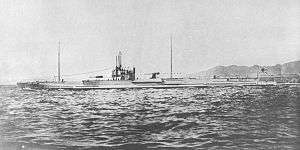Yokosuka E6Y
| Yokosuka E6Y | |
|---|---|
 | |
| The submarine I-5, which carried the E6Y |
The Yokosuka E6Y (long designation: Yokosuka Navy Type 91-1 Reconnaissance Seaplane (九一式水上偵察機)) was a Japanese submarine-based reconnaissance aircraft developed at the Yokosuka Naval Air Technical Arsenal for the Imperial Japanese Navy during the 1920s. The aircraft first flew as the prototype Yokosho 2-Go (long designation: Yokosuka Navy No. 2 Reconnaissance Seaplane (式二号水上偵察機)) in 1929 and was a single-seat biplane that could be quickly assembled and disassembled so that it could be stored onboard a submarine. Ten production machines were built with the designation E6Y by Kawanishi in the 1930s and served with the Japanese submarine aircraft carriers I-5, I-6, I-7 and I-8 until replaced by the Watanabe E9W in 1938. They saw limited action during the January 28 incident.
Development
The Imperial Japanese Navy was a pioneer in naval aviation, starting as early as 1912 with the purchase of two floatplanes from Britain and one from the United States.[1] By December 1922, Japan had completed Hōshō, which vies with Hermes as the first ship purpose-designed for aircraft operations.[2] Alongside that development, the Navy also looked at aircraft as a way to extend the operational reach of their large submarine force. Aware of the challenge of operations in the large expanse of the Pacific Ocean, the Navy was particularly looking at ways to improve their reconnaissance capability and saw submarine-based aircraft as a complement to land--based patrol.[3] They acquired a Caspar U.1 from the United States and a Parnall Peto from Britain, both early submarine-based reconnaissance aircraft.[4] The two aircraft formed the basis for two prototype Japanese aircraft built for submarine-based reconnaissance, the 1-Go based on the former, while the latter heavily influenced the 2-Go.[5]
Design
The Yokosuka Naval Air Technical Arsenal (海軍航空技術廠 Yokosuka Kaigun Kōshō), which was abbreviated to Yokosho, developed the 2-Go as a smaller aircraft that the Peto. It was a sesquiplane of mixed construction, with a steel frame and wooden-framed wings, covered in canvas.[6] The wings were designed to detach for storage, as was the twin float assembly, which was also wooden. The first prototype was powered by the same engine as the Peto, an Armstrong Siddeley Mongoose five-cylinder radial engine, rated at 130 hp (97 kW), but manufactured under license by Mitsubishi.[6]
The second prototype, designated 2-Go Kai, differed in a number of details. Lateral stability issues were resolved by increasing the tail fin and rudder, extending them upward.[6] The aircraft was fitted with a more powerful Japanese Gasuden Jimpu seven-cylinder radial, rated at 160 hp (120 kW), which gave a maximum speed of 169 km/h (105 mph) and four and a half hours endurance.[5]
In 1931, the Kawanishi Aircraft Company was commissioned to produce eight production machines, designated E6Y1, based on the 2-Go Kai, which were built between 1932 and 1934.[6]
Operational history
The Navy took delivery of the 2-Go in May 1929 and initially tested it aboard the submarine I-51.[7] Testing was completed by September 1931.[6] The 2-Go Kai commenced testing in 1931 initially also on board I-51 and then subsequently the Junsen I Mod type submarine I-5. I-5 was not fitted with a hanger, but rather the aircraft was disassembled and stored in two cylindrical containers, one for the fuselage and the other for the wings, stored on the deck.[7] Launch was initially from the water, but a catapult was fitted to I-51 in 1933 and this was found more satisfactory. All subsequent Japanese aircraft-carrying submarines used catapults.[3]
The first production E6Y entered service in 1933, and the eight aircraft were deployed to the three Junsen II and III submarines,I-6, I-7 and I-8.[7] The aircraft also saw surface ship use.[4] They saw limited service during the January 28 incident in 1932, providing reconnaissance, and subsequently there are reports that they served on submarines that operated during the Second Sino-Japanese War in 1937.[7] The E6Y was replaced by the Watanabe E9W in 1938.
Variants
- Yokosho 2-Go
- First prototype equipped with a 130 horsepower (97 kW) Armstrong Siddeley Mongoose produced under license by Mitsubishi.
- Yokosho 2-Go Kai
- Second prototype equipped by a 160 horsepower (120 kW) Gasuden Jimpu.
- E6Y1
- Production version of the 2-Go Kai manufactured by Kawanishi.
Operators
Specifications (E6Y1)
Data from Mikesh & Abe, 1990[6]
General characteristics
- Height: 2.87 m (9 ft 5 in)
- Wing area: 26.70 m2 (287.4 sq ft)
- Empty weight: 570 kg (1,257 lb)
- Max takeoff weight: 750 kg (1,653 lb)
- Powerplant: 1 × Gasuden Jimpu 7-cylinder radial, 120 kW (160 hp)
Performance
- Maximum speed: 169 km/h; 105 mph (91 kn)
- Range: 600 km (373 mi; 324 nmi)
- Endurance: 4.4 hours
- Service ceiling: 4,800 m (15,700 ft)
- Time to altitude: 3,000 m (9,800 ft) in 20 minutes 14 seconds
- Power/mass: 5.77 kg (12.7 lb)/hp
Armament
- None
See also
Aircraft of comparable role, configuration and era
Related lists
References
- ↑ Polmar 2011, p. 34.
- ↑ Polmar 2011, p. 35.
- 1 2 Geoghegan 2013, p. 53.
- 1 2 Carpenter & Polmar, p. 6.
- 1 2 Marriott 2006, p. 154.
- 1 2 3 4 5 6 Mikesh & Abe 1990, p. 279.
- 1 2 3 4 Volckov 2014.
- Carpenter, Dorr; Norman, Polmar (1986). Submarines of the Imperial Japanese Navy. London: Conway Maritime Press. ISBN 978-0-851-77396-4.
- Geoghegan, John (2013). Operation Storm: Japan's Top Secret Submarines and Its Plan to Change the Course of World War II. New York: Crown Publishers. ISBN 978-0-307-46480-4. Retrieved 6 October 2018.
- Marriot, Leo (2006). Catapult Aircraft: Seaplanes That Flew From Ships Without Flight Decks. Barnsley: Pen and Sword. ISBN 978-1-844-15419-7.
- Mikesh, Robert C.; Abe, Shorzoe (1990). Japanese Aircraft 1910-1941. London: Putnam. ISBN 978-0-851-77840-2.
- Polmar, Norman (2011). Aircraft Carriers: A History of Carrier Aviation and Its Influence on World Events, Volume II: 1946-2006. Dulles: Potomac Books. ISBN 978-1-597-97343-4.
- Volkov, Dale (2014). "E6Y". Уголок неба (in Russian). Retrieved 7 October 2018.